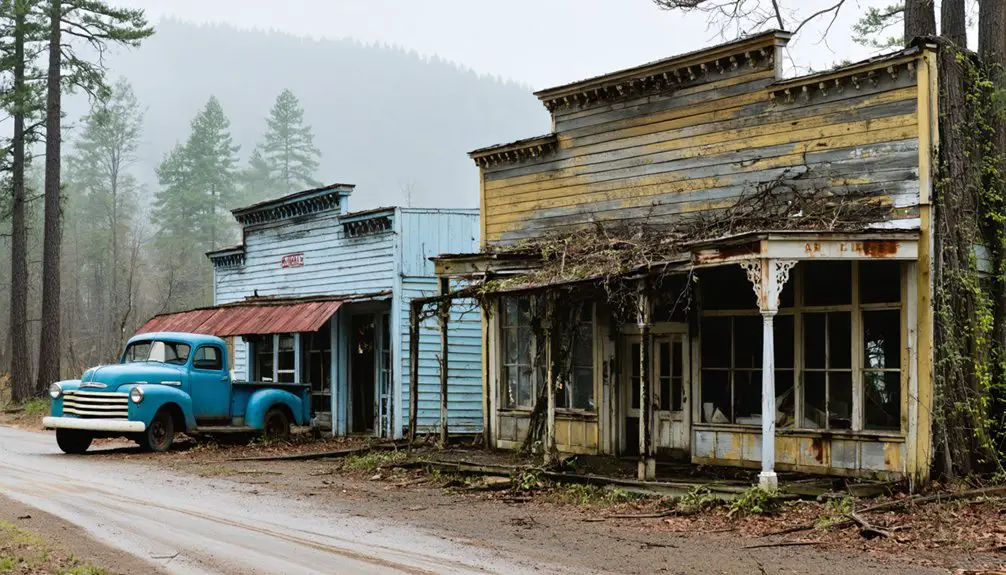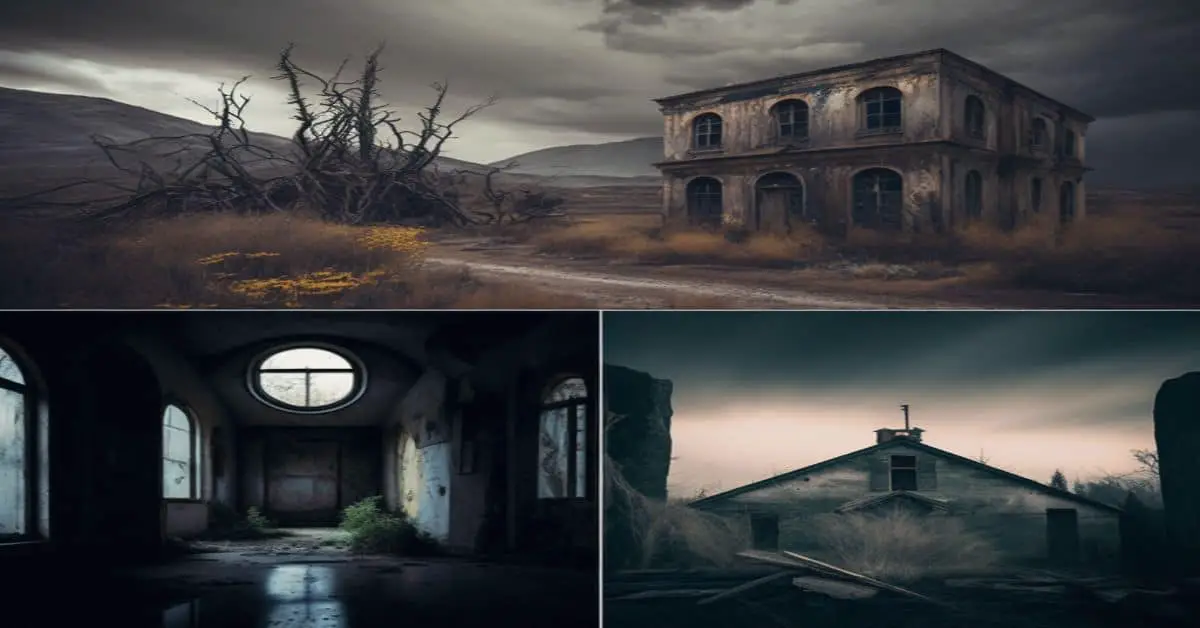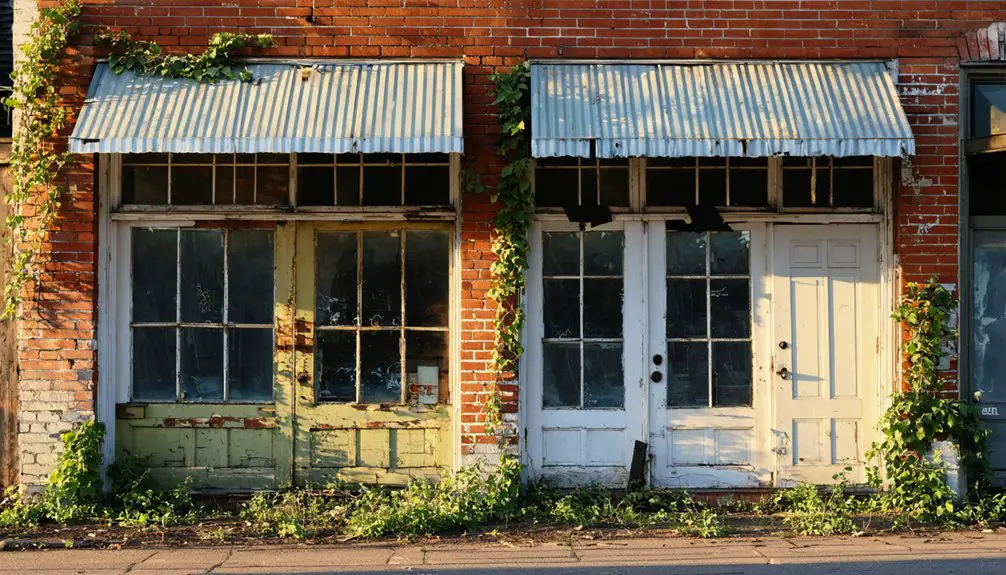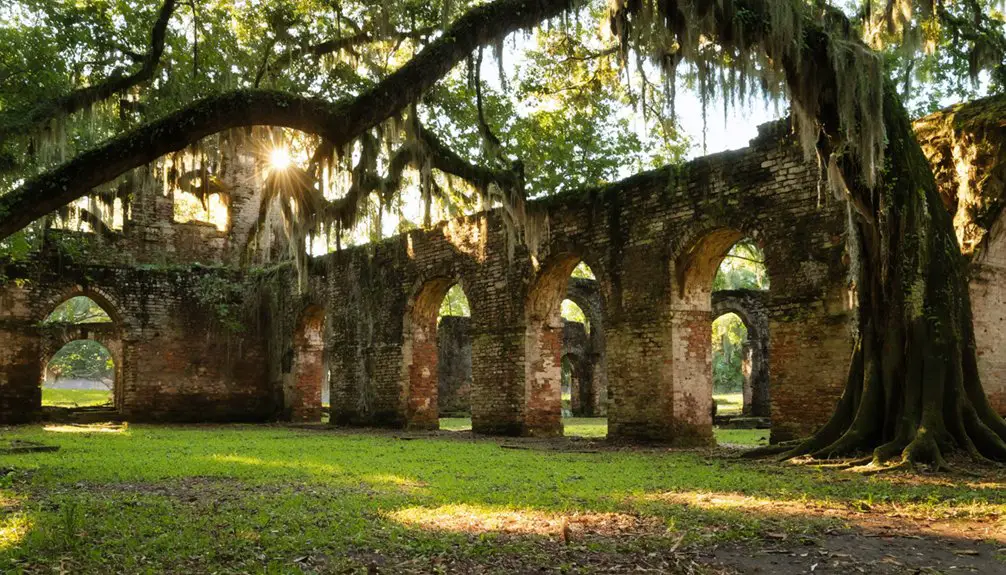You’ll discover the haunting story of Glenville, NC, a once-thriving mountain town that vanished beneath Lake Glenville’s waters in 1941. Originally called Hamburgh, this 19th-century settlement grew into Jackson County’s largest town by 1891, with 240 residents, nine stores, and the region’s first high school. When Nantahala Power & Light needed hydroelectric power, they flooded the valley, forcing residents to relocate and burning the town. The lake’s depths still hold secrets of old Glenville’s past.
Key Takeaways
- Glenville was a thriving mountain town with 240 residents, nine stores, and multiple businesses before being deliberately flooded in 1940.
- The original townsite was burned and submerged under 300 feet of water when Nantahala Power & Light created Lake Glenville.
- Nearly 600 graves were exhumed and relocated during the flooding project, disrupting historical connections to the original settlement.
- Remnants of the burned ghost town still rest at the bottom of Lake Glenville, completely hidden from view.
- The flooding forced residents to relocate, fragmenting the community and transforming the area into a modern lakeside retreat.
Early Settlement and Origins
As settlers pushed westward into North Carolina’s mountainous terrain during the 19th century, they discovered the area that would become Glenville.
You’ll find that these early pioneers, mostly of Scots-Irish and German descent, established homesteads in natural clearings near water sources. The rugged landscape influenced their settlement patterns, leading to scattered farms across the elevated terrain.
These hardy settlers adapted to frontier life, developing a self-sufficient lifestyle that combined farming with hunting and gathering. The community used 300,000 feet of lumber from local forests to construct their dwellings and outbuildings. They built homes using local timber and stone, creating a community bound by mutual aid and shared labor. Like the later development of Ghost Town in the Sky at 4,650 feet elevation, the early settlers chose high-altitude locations that provided panoramic views of the surrounding wilderness.
Despite the isolation imposed by limited transportation routes and challenging terrain, you’ll notice how their settlement patterns reflected a tight-knit community dynamic, centered around small churches and informal gathering spots.
From Hamburgh to Glenville: A Town’s Evolution
You’ll find the town’s earliest roots as a simple trading post that carried the name “Hamburgh” before adopting the simplified spelling “Hamburg.”
The growing settlement gained prominence as the largest town in Jackson County by 1891, when it officially changed its name to Glenville to prevent confusion with the township name. Due to the nature of similar place names, this change exemplifies the importance of name disambiguation in historical records.
That same year, the town’s private high school, the first in Jackson County since 1886, shifted to public status, cementing Glenville’s role as an important educational center in the region. The school continued serving students through grades 1-11 until 1975, when it was finally abandoned.
Early Trading Post Origins
The small trading post of Hamburgh emerged in the early 1800s along the banks of the Tuckasegee River, marking the beginning of what would later become Glenville, North Carolina.
By 1827, the settlement had established itself as both a trading hub and protective outpost against the Cherokee nation, nestled near a commanding 200-foot waterfall.
As a crucial connection point between surrounding communities like Norton, Yellow Mountain, and Pine Creek, the trading post steadily grew into a thriving center of commerce.
You’d have found nine stores, two blacksmith shops, and three gristmills serving the region’s needs.
The community’s strategic location along historic Trading Paths fostered its development, and by 1890, you could count roughly 40 homes housing 240 residents in this burgeoning mountain settlement.
Today, the area’s pristine natural beauty continues to draw visitors and residents alike, much as it did in its early trading post days.
In 1891, the town’s name officially changed to Glenville, drawing inspiration from the The Glenville House inn.
Growth Through Name Changes
While the trading post flourished under its original name, Hamburgh’s identity would soon evolve to match its growing ambitions. The name significance of this change became apparent in 1891 when Postmaster Elisha C. Hedden pushed to rename the settlement “Glenville” to distinguish it from the surrounding Hamburg township. Similar to other distinct Glenville locations across the country, this settlement carved out its own unique identity.
The new name drew inspiration from the local Glenville House inn, cementing a fresh community identity.
- You’ll find about 40 homes dotting the Tuckasegee River banks by 1890
- You can spot the town’s first private high school, established in 1886
- You’ll notice a thriving Baptist church serving the growing population
- You’ll discover a spectacular 200-foot waterfall nearby
Despite a failed attempt at incorporation, the Glenville name stuck, reflecting the town’s spirit of independence and progress.
Educational Hub Development
Following Hamburgh’s early settlement in the 1820s, educational development emerged as a cornerstone of community growth when Jackson County’s first private high school opened its doors in 1886. Modeled after Cullowhee High School, this institution pioneered rural innovation in Western North Carolina’s community education.
In 1891, as the town became Glenville and grew into Jackson County’s largest settlement, the school changed to public status. By 1926, a new hillside campus overlooking the town served grades 1-11, cementing Glenville’s role as an educational hub.
The 1950s brought expansions to address overcrowding, and the school continued serving the region until 1975. The area’s commitment to education mirrored the growth of Western Carolina University, which evolved from a primary school to become a major regional institution. However, the creation of Lake Glenville in the 1940s dramatically altered the landscape, eventually contributing to the school’s closure and demolition around 2000.
Educational Legacy and Community Pride
Since its establishment in 1925, Glenville High School emerged as a cornerstone of community identity, operating from a modern brick building that featured 10 classrooms, a gymnasium, and cafeteria.
The school’s educational continuity strengthened community nostalgia as multiple generations of local families attended classes on the hilltop overlooking the original village.
- You’ll find proud alumni connections spanning from the 1940s through the 1960s, with parents and grandparents sharing the same halls.
- The school hosted events, sports competitions, and graduations that brought the mountain community together.
- Notable educators like Julia Frizzell Stewart created lasting legacies, with their descendants all graduating from Glenville High.
- Even after the school’s demolition, Schoolhouse Road preserves its memory, reminding visitors of the institution’s significance in local culture.
The school served as an educational beacon for fifty consecutive years until its final classes in 1975. The site now serves as one of the region’s most significant ghost town landmarks, attracting historians and tourists interested in Appalachian heritage.
The Great Submersion: Creation of Lake Glenville
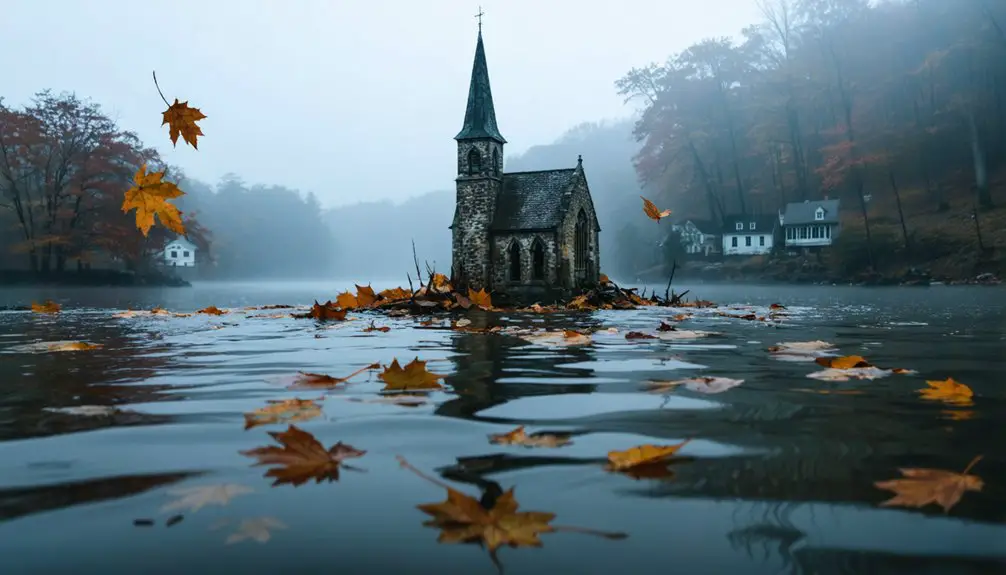
You’ll find the origins of Lake Glenville in 1940 when Nantahala Power & Light began implementing plans to dam the west fork of the Tuckasegee River at Onion Falls.
The project forced about 240 residents to abandon their homes, businesses, and farmlands, while workers relocated roughly 580 graves and burned remaining structures to clear the future lakebed.
Flood Plans Take Shape
In 1930, Nantahala Power & Light, a subsidiary of Alcoa, set in motion ambitious plans to transform the Glenville valley through an extensive flooding project. The flooding strategies evolved from initial modest plans to a bold vision of creating a 1,450-acre lake by damming the west fork of the Tuckasegee River.
Despite community resistance, the project moved forward to support wartime aluminum production.
- Land acquisition began near Onion Falls, targeting the valley north of Cashiers.
- Plans expanded to include a three-mile tunnel for water diversion.
- Construction crews worked 24/7 under electric floodlights starting June 1940.
- The project would submerge the entire valley, including schools, homes, and farmland, beneath up to 300 feet of water.
Residents Face Forced Relocation
The flooding of Glenville brought devastating changes to its residents, who faced mandatory relocation as North Carolina Power and Light’s dam project moved forward.
You’d witness profound community fragmentation as families were uprooted from their homes, with some choosing to rebuild nearby while others left permanently.
The cultural loss ran deep – about 580 graves had to be exhumed and relocated a half-mile away, severing generations-old connections to the land.
NP&L’s corporate interests trumped resident consent, forcing a stark transformation of their mountain town into a lakeside community.
After residents moved out, you’d see the original townsite and timber intentionally burned to clear the future lakebed, erasing physical traces of Glenville’s heritage forever.
Lake Transforms Mountain Valley
When construction began in June 1940, Nantahala Power and Light‘s ambitious dam project aimed to meet wartime electricity demands by transforming the Glenville valley into a vast reservoir. The creation of Lake Glenville forever changed the mountain landscape, submerging the original town under hundreds of feet of water.
You can imagine the dramatic transformation as:
- The rushing Tuckasegee River was tamed into a 1,470-acre lake ecosystem
- Original farmlands, roads, and buildings disappeared beneath 300 feet of water
- Mountain valley flora gave way to an expansive water basin
- Community nostalgia lives on in the lake’s depths, where burned remnants of the old town still rest
The project’s 24/7 construction schedule, illuminated by temporary floodlights from Franklin, marked the swift shift from valley to reservoir, fundamentally altering both geography and way of life.
Preserving Heritage: Relocated Landmarks
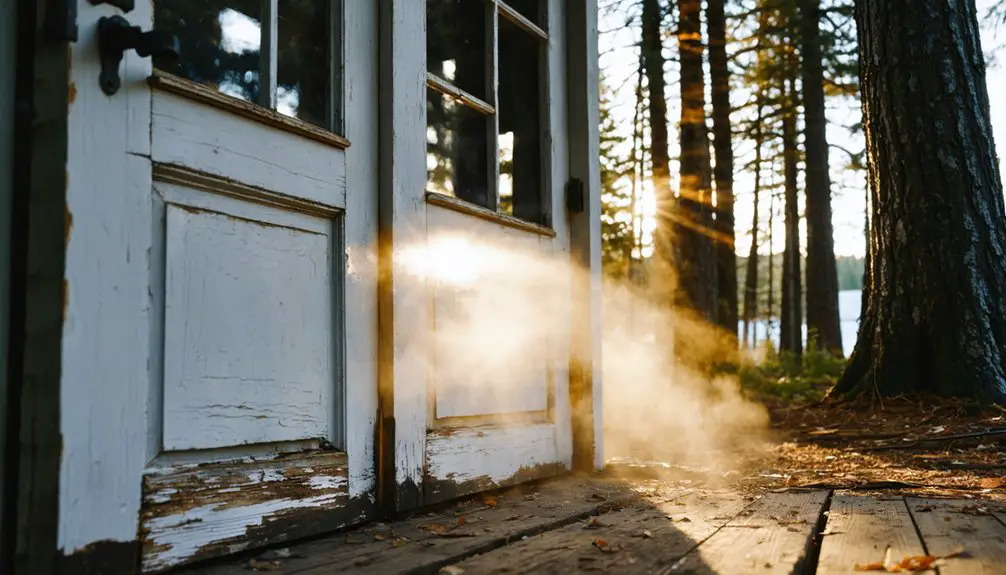
During the creation of Lake Glenville reservoir, preservationists undertook the essential task of relocating key landmarks from the soon-to-be-submerged village. They carefully dismantled historic buildings, cataloged original furnishings, and transported these pieces of heritage to nearby locations.
You’ll find these preserved structures now serve as museums and cultural centers, maintaining their cultural significance for future generations.
The relocated landmarks have become crucial tourist attractions, drawing history enthusiasts and educational groups to experience Western North Carolina’s past firsthand. You can explore authentically restored interiors, attend traditional music performances, and participate in cultural events.
While the preservation process faced challenges like structural vulnerability and high relocation costs, these saved landmarks now stand as living testimonies to Glenville’s rich Appalachian heritage.
Life Before the Lake
Before Lake Glenville transformed the landscape, a vibrant mountain community took root in 1827 as “Hamburgh,” later shortened to “Hamburg.”
While preserved landmarks tell part of the story, understanding life in early Glenville reveals a deeper historical narrative.
The community dynamics of pre-lake Glenville centered around these key aspects:
- You’d find a close-knit community where education played a central role, beginning with the county’s first private high school in 1886.
- The town’s cultural heritage revolved around its church and graveyard, serving as gathering places for residents.
- You’d experience a traditional mountain lifestyle, with local commerce supporting daily life.
- Despite its small size, you’d be part of Jackson County’s largest incorporated town, where neighbors knew each other and children walked to the hillside school.
Environmental Impact and Geographic Changes
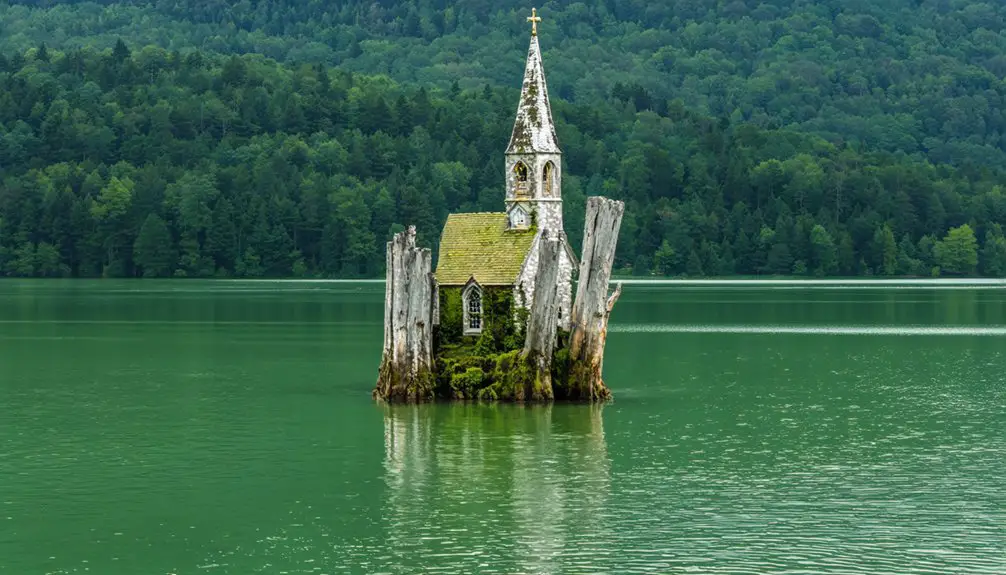
In response to ALCOA’s urgent need for wartime aluminum production, the construction of Lake Glenville in 1941 dramatically transformed the region’s environmental landscape. The creation of the 1,470-acre reservoir submerged the original town, multiple creeks, and extensive riparian habitats, forcing significant geographic transformations throughout the area.
You’ll find the environmental changes weren’t limited to the surface. The damming altered the Tuckasegee River’s flow and ecology, impacting native aquatic species and changing sedimentation patterns.
The region’s challenges didn’t end there – geological instability has plagued nearby areas, particularly around Ghost Town in the Sky, where landslides and retaining wall failures have threatened homes and infrastructure since the 1960s.
Today, the lake serves dual purposes: generating hydroelectric power while providing recreational opportunities, though careful management is required to balance these competing needs.
Modern Transformation Into a Lakeside Retreat
The modern reinvention of Glenville began with a bold $200 million investment plan following the property’s 2021 purchase.
You’ll find the transformation focuses on creating a vibrant lakeside retreat that blends Old West charm with contemporary amenities.
Despite ownership changes and legal challenges following Alaska Presley’s death in 2022, development plans continue to move forward with community engagement at the forefront.
- Creation of a Biltmore Village-style development featuring niche retail and residential housing
- Integration of Broadway at the Beach-style attractions with an RV resort for diverse lodging options
- Preservation of historic Western buildings with modern infrastructure upgrades
- Development of lakeside amenities that connect the natural setting with new shopping and residential areas
The project aims to establish a year-round destination that serves both tourists and permanent residents.
Historical Significance in Appalachian Development
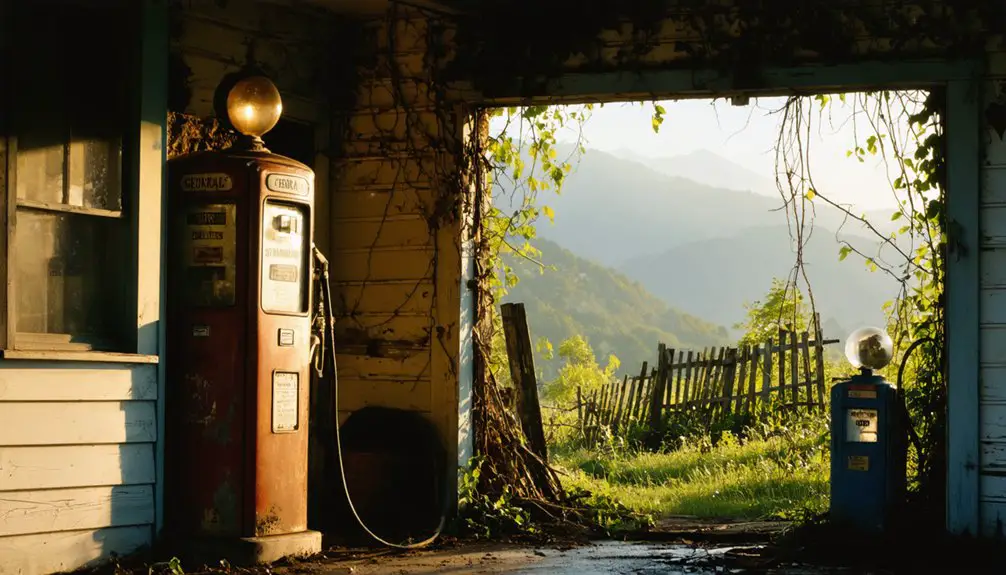
Originally established as Hamburgh in the early 1800s, Glenville emerged as one of Jackson County’s earliest settlements and grew into a significant frontier outpost.
You’ll find that the town played a vital role in shaping Appalachian culture through its strategic position as both a defensive fort against Cherokee conflicts and a thriving river community.
By 1890, it had become the largest town in Jackson County, boasting a self-sustaining historical economy with forty homes, multiple businesses, and the region’s first public high school.
The town’s evolution from a frontier settlement to an educational hub reflects the broader development patterns of Appalachian communities, while its eventual submersion under Lake Glenville represents the sacrifices many mountain towns made for regional progress.
Frequently Asked Questions
Can Visitors Scuba Dive to See Remnants of the Original Town?
You can scuba dive for underwater exploration in Lake Glenville, but you’ll need advanced certification and local knowledge. Unlike Fontana Lake’s organized ghost town dives, there aren’t established tours here.
What Happened to the Families Who Refused to Relocate?
You’ll find that families who refused relocation faced harsh consequences: their properties submerged, livelihoods disrupted, and family histories fractured. Many eventually left anyway due to isolation and lack of community support.
Are There Any Annual Events Commemorating the Original Town of Glenville?
Like footprints washed away by time, you won’t find any annual events commemorating Glenville’s history or town folklore today. The area’s festivals focus on regional culture rather than the original settlement’s legacy.
What Was the Compensation Offered to Residents During the Lake Project?
You’d have received compensation during the lake project based on federal relocation laws, including moving expenses, property search costs up to $2,500, and potential payments of $22,500 for owners or $5,250 for tenants.
Do Any Original Glenville Structures Remain Above Water Today?
You won’t find any original architecture from old Glenville above water today. The town’s submerged history lies entirely beneath Lake Glenville’s surface, with all structures permanently flooded since the 1940s.
References
- https://abandonedin360.com/abandoned-commercial-properties/ghost-town-village/
- https://kids.kiddle.co/List_of_ghost_towns_in_North_Carolina
- https://en.wikipedia.org/wiki/Glenville
- https://en.wikipedia.org/wiki/List_of_ghost_towns_in_North_Carolina
- https://www.romanticasheville.com/henry-river
- https://en.wikipedia.org/wiki/Ghost_Town_Village
- https://blueridgemountainlife.com/ghost-town-in-the-sky-maggie-valley-nc/
- https://thelaurelofasheville.com/lifestyle/history-feature-love-and-lawlessness/
- https://www.romanticasheville.com/ghost_town.htm
- https://www.randomconnections.com/disrupted-paradise-at-lake-glenville/
